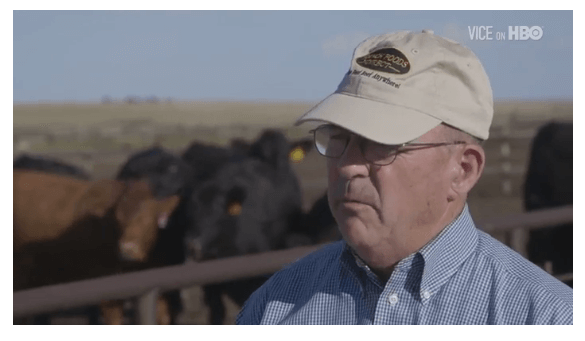Examining the environmental harm of our meat addiction; assessing the depths of the world’s water crisis.
Mike Callicrate: It takes about 2,500 gallons of water to produce a bushel of corn. And if an animal eats 50 bushels of corn in it’s time in the feedlot, we’re looking at about 125,000 gallons of water per animal under the industrial model.
Isobel Yeung: So when it comes to those industrial scale feedlots, the majority of the water they’re using actually goes into producing the corn.
Mike Callicrate: That’s correct. And the reason that JBS has a big feedlot at Yuma Colorado is because there’s water. And they don’t pay one dime for that water. And they pay below the cost of production of that corn. The corn is the cheapest thing that we can feed because we buy it below cost of production. The water is subsidizing that operation.
Isobel Yeung: So with free water and cheap corn, the price of mass produced beef is kept artificially low.
Mike Callicrate: The question is: How much of the Ogallala aquifer do we need to support an industrial model or any model as far as that goes. And if we are so foolish as to let that precious resource run out, that’s a tragedy.
Isobel Yeung: Mike showed us the scale of land and water used by the giant meat producers here. So we’re just flying over Yuma County here in Colorado. This is one of the huge huge scale feedlots. You’ve got 100,000 cattle in this one feedlot down here. Is this all corn down here, these circles?
Mike Callicrate: Yes! Basically all of the circles that you’re seeing here is corn.
Isobel Yeung: That’s a lot of corn fields.
Mike Callicrate: Everywhere you see a circle, is pumping water. I think we have to have a true cost accounting going into these production models. The reason that these big companies can do what they do is because they’ve got the power to externalize so many of their costs. Whether it’s water. Whether it’s the pollution of the soil with the overuse of chemicals and the production of the crops. Environmental damage. That’s how we’re able to get a dollar burger at McDonald’s. And we’re not thinking about the future. We’re only thinking about the short term.














what yield of corn and how many acre feet of water to irrigate an acre
200 bu /acre at 2500 gal is 500,000 gal per acre
i think an acre foot is 125000 gal so 4 acre feet of water to produce 200 bushels of corn
if the Ogallala is pulled down the beef will have to come from Brazil
Thanks for all the information. I continually forward what you post.
https://flatlandkc.org/news-issues/agriculture-built-high-plains-towns-now-it-might-run-them-dry/